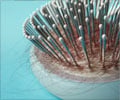What is hair analysis?
In 1982, microscopic hair analysis of strands found on the body of a victim was used and Dennis Fritz and Ron Williamson were framed for the murder. Seventeen years later, DNA analysis of the same hair fragments was used to prove that these men were innocent.
As this case shows, hair analysis has come a long way the past thirty years.

Hair analysis, basically, is the scientific examination of a hair sample. It can be hair from a crime scene examined to find out who committed the act, or it can be hair taken from the back of your head and sent to a laboratory where it is checked for signs of health problems.
Hair analysis is still an evolving science, and while it has a lot of potential, we need to be careful about what we expect hair analysis to tell us about the person whose head it used to grow on.
The scientific basis of hair analysis
The scientific basis of hair analysis is simple: when new hair cells are forming in the hair follicle, they take in traces of substances going through the blood stream of the individual. As hair grows, the new cells push out the older ones, and as cells come out of the bulb, they die and harden - and thus create a long lasting record of whatever was in the blood of the person when they were forming.
Besides the hair stand itself, the sebum that coats the hair (from the sebaceous gland connected to the hair follicle) also contains traces of the drugs and minerals flowing through your body. And if the root or the root sheath is attached to the hair, it also provides a deoxyribonucleic acid (DNA) record.
Hair can thus keep a more long-lasting record of what passes through the body of an individual than either blood or urine – the body fluids which are usually used for such tests. Each hair lives about 5-6 years before it falls off the scalp.
Hair analysis techniques
A trichogram is a physical macro- and microscopic examination of hair and the scalp – the kind of hair analysis which was used to convict Dennis Fritz and Ron Williamson. Today doctors use this mainly to find out why a person is losing hair, or how much of his hair are in the growing or resting or falling phases.
Modern, more sophisticated, hair analysis uses gas chromatography/mass spectrometry (GC/MS) to chemically test hair or find its DNA composition. Usually, a pencil-tip thickness of hair close to the body (from the region behind the head just above the neck) is cut out. The hair closest to the scalp is used because it is the most recent growth, and it can be expected to show the most recent condition of the body.
The hair is usually dissolved for this procedure and the extract is analyzed for minerals, drugs, toxins or heavy metals. This data is also used, more controversially, to diagnose diseases and deficiencies/excesses in your system.
Modern methods are sensitive enough to find traces of minerals/metals/drugs that are a thousandth of a gram (microgram), or a nanogram (one billionth of a gram) or even a picogram (one thousandth of a nanogram) per gram of hair.
Hair analysis for minerals, drugs and toxins
Hair analysis is a standard medical test for chronic arsenic poisoning – the stuff of whodunits, but in real life more often seen in agricultural workers who inhale fumes containing arsenic from insecticide sprays or dust.
Another accepted use of hair analysis is to show if someone has been taking illegal drugs – cocaine, marijuana, amphetamines, or alcohol. The analyst checks for the presence of the substances themselves or their metabolites (the products of the body’s metabolism of these substances) in the strand of the hair. The results of such tests have been acceptable in courts of law a long time.
But there are a few problems with this analysis –
1. False positive or negative results are possible, so results always need to be confirmed by another technique.
2. If hair analysis shows a positive result for a substance, it is difficult to say where it came from especially if it is quite commonly found. For example, for illegal drugs like marijuana a positive result might mean the person consumed the drug, or it might only mean he was physically close when someone else was smoking it.
Hair analysis in forensics
One hair analysis case in Germany in 1990s involved a dog suspected of causing a traffic accident. Later this particular dog was found innocent of the crime because DNA taken from the dog did not match DNA taken from dog hair fragments stuck to the car.
A physical examination of the hair found in the crime scene, sometimes under a microscope, can show details like the race a person belongs to, and it be used to rule out possibilities. At this level, evidence cannot be used to identify a single person. But this can be done if the hair has root or root sheath material attached, which can be used for DNA analysis of the hair. DNA fingerprinting is accepted as definitive evidence.
Hair analysis is also used in forensics to check if a person has been sticking to a drug regimen (or a no-drug regimen). A person’s hair keeps a record of amphetamines, opium, cocaine, marijuana, and alcohol ingested for months. While hair analysis will not show if someone was driving under the influence or smoked pot yesterday (because even the hair closest to the scalp can be weeks old), it can show if he has been taking alcohol or pot the last month (or three or four or more months, depending on the length of hair available for analysis).
Hair analysis potential and limits
Where testing for long-term consumption of drugs is concerned, hair analysis is becoming more common than blood or urine analysis. It’s easier, less invasive of privacy, and there is less chance of tampering so long as the ‘chain of custody’ is carefully maintained.
Hair analysis in these forms has long been acceptable in courts of law, but its limits must always be kept in mind:
- It can show false positives through environmental exposure (for example, to marijuana smoke). The samples are usually washed in water as well as an organic solvent to prevent this.
- We don’t know yet what the normal range in hair is for most drugs. We also don’t know what is the relation between the amount of the drug or alcohol someone may consume and the amount of it, or its metabolite, that should turn up in his hair.
- Washing with shampoos and bleaching and dyeing remove some substances and deposit others - even heavy metals. There has been no research so far into this.
- Age, sex, the seasons, the geographical area, and even the place from which the hair was taken (head or body) can have an effect on the concentration of any substance found in hair.
Hair analysis for health evaluation
This is the kind of hair analysis most of us may be persuaded to try out – and it is also the most unreliable and controversial form of hair analysis. Dr. Stephen Barrett called it ‘the cardinal sign of quackery.’ Laboratories, websites, and health care ‘consultants’ claim to examine your hair and diagnose diseases and deficiencies from autism to fibromyalgia. Based on what your hair tells them, most of them will also try to sell you ‘specially formulated’ supplements or medicines.
Here are some signs that your hair analyst is not trustworthy:
- He tells you to depend only on his hair analysis results. This goes against the accepted medical principle that laboratory results should always supplemented by physical and other examinations.
- He tests for 20 or 30 minerals and vitamins in a single hair test.
- He tries to sell you medicines based on his hair analysis.
Several studies (including one by Dr. Barrett and another one in 2001 in Germany) which sent samples of hair from a single healthy person or two healthy people to many commercial laboratories found wild variations in the results and reference ranges in the laboratory reports.
The American Medical Association calls this - hair analysis for medical therapy - an ‘unproven practice with potential for healthcare fraud.’ Most insurance companies do not pay for this kind of hair analysis (except for arsenic tests).
So if anyone offers to analyze your hair to find out what disease you suffer from, Dr. Barrett’s advice is to run for your state attorney general!
Hair analysis: can it help you?
So far, hair analysis has been used by toxicologists and by law enforcers. But as an aid to therapy or diagnosis, hair analysis is not necessary - yet. The American Medical Association says hair analysis “will remain limited until validation by the standard methods of clinical investigation is achieved.”









